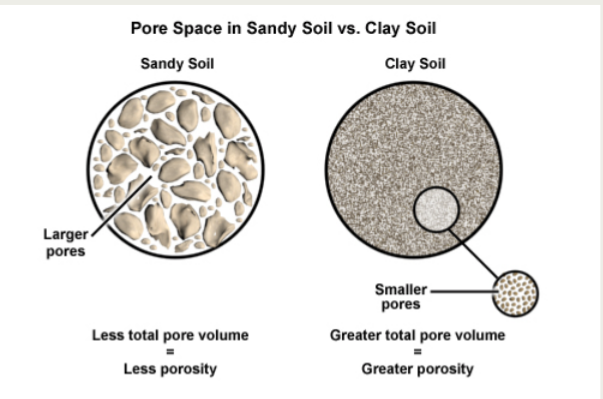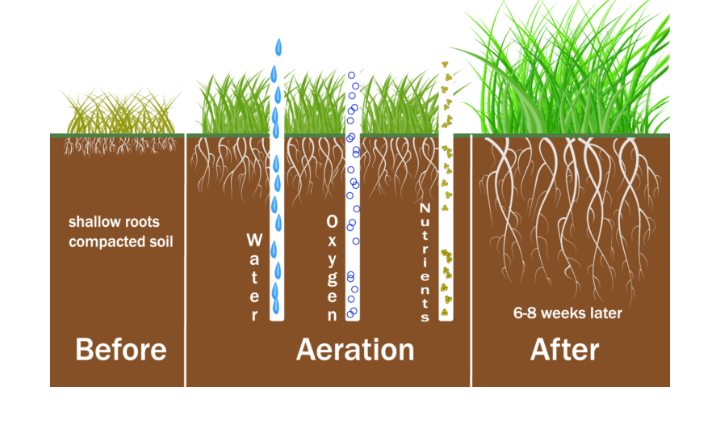
Good fertile soil, adequate amount of water in soil, temperature control, and even soil test are very important factors for optimum growth of plants but still plants may lack vigor, not flower, and exposed to diseases etc if soil is not properly aerated.
In soils, pores are sheared by air and water. An abundant of one will mean depletion of the other.
Soil air is the air which fills the soil pores that are free of water. Air is supplied from underground by moving O2 and CO2 between the earth pores and the atmosphere. It helps avoid oxygen starvation in crops and reduce harmful carbon dioxide levels in the subsurface air if they rise too high.
Plant roots require atmospheric oxygen to respire and release energy for their needs from the glucose-oxygen reaction. In anaerobic soil condition, roots are deprived of oxygen, causing improper breathing, making roots to find it difficult to absorb nutrients and water, so the plant eventually dies. The impact of aeration on soil is not limited to crop growth alone but also necessary for aerobic soil microorganisms.
SOIL AERATION: This is the exchange of oxygen and carbon dioxide of the soil air with the atmosphere. It is one of the determinant of good soil health. It brings about exchange of oxygen and carbon dioxide between the soil air and atmospheric air. Apart from oxygen and carbon dioxide, other gases involved in the soil air atmosphere include various volatile forms of nitrogen, ammonia, NO, NO2, N2O, volatile forms of sulphur, H2S, SO2, and hydrocarbons like methane. etc. Some of these gases are green house gases (GHG).
IMPORTANCE OF SOIL AERATION
1. Aerating the earth allows grass and crops to develop stronger roots and become healthier overall, leading to lush, thick growth
2. It helps farm by allowing water, oxygen, fertilizer, lime or seeds to penetrate the earth.
3. When soil is adequately aerated, water trickle into the soil, preventing runoff and improving drainage.
4. It is an indicator of a properly drained soil
5. Potted plants and Plants that have flourished in the past may suddenly wilt, drop leaves, and not bloom, as they are unable to respire from soil compaction around their roots
6. Absence of good soil aeration can cause a harmless weak pathogen to become extremely distructive
7. Lack of soil aeration and waterlogging can favour the build up of water mold pythium and phytopthora
8. Good soil aeration can suppress or restrict root rot
9. Poor soil aeration leads to anaerobic conditions on the metabolic processes within the plant which inturn affect the absorption and accumulation of ion.
10. Poor soil aeration result in farmer losing crops and money
SOIL AIR COMPOSITION AND FACTORS INFLUENCING IT
Oxygen is 20.94% in the atmosphere and 20.03 to 10.35% or less in soil air. Carbon dioxide is about 0.03% in the atmosphere but 0.1 to 5% in the soil air. Nitrogen is about 78.01% in the atmosphere and 80.24 in the soil.
Some of the factors that influence soil air include:
a. MICROBIAL ACTIVITIES : This tends to keep carbon dioxide concentration higher with consequent reduction in oxygen concentration.
b. ORGANIC MATTER CONTENT : Such as farmyard manure, green manure, compost etc decompose to produce carbon dioxide.
c. PLANT ROOT RESPIRATION : Roots releases carbon dioxide and consume oxygen
d. SOIL TEXTURE : Coarse textured soils has higher gases compared to fine soil particles.
e. Soil structure
f. CROPS : Tendency of growing crops to reduce oxygen in soil air will lead to carbon dioxide build up
g. TILLAGE OPERATION : This can cause soil compaction
h. DRAINAGE : In a poorly drained soil, there is less oxygen than well drained soil
I. WATER CONTENT : abundance of water will lead to reduction in air composition
J. SEASONALITY : Effect of season stems essentially from water and temperature variation as this influences plant and microbs
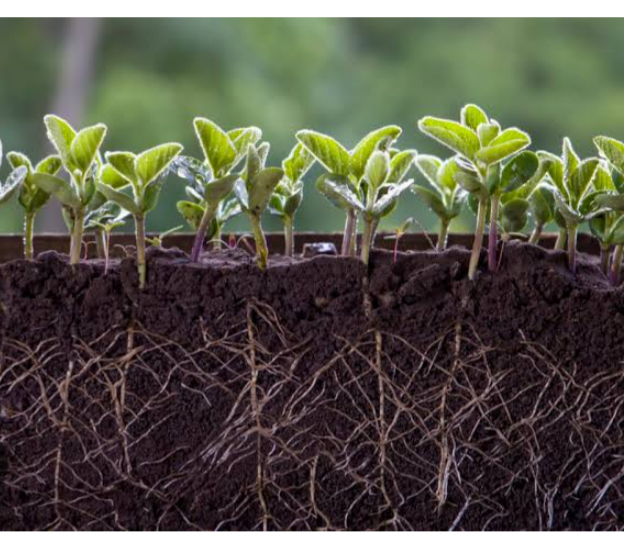
FACTORS THAT AFFECT SOIL AERATION
1. SOIL STRUCTURE AND TEXTURE : It can be stated that any soil characteristics that is responsible for a large air capacity such as coarse textured or granulated structure and which is relatively free of water usually favour a low amount of carbon dioxide and high oxygen content of the soil air. For example, Granular soils contains less carbon dioxide than fine particle soils, loamy soils contains more carbon dioxide than sand. The amount of carbon dioxide increases with soil depth.
2. MOISTURE CONTENT OF THE SOIL /DRAINAGE : When gas exchange between the soil air and atmosphere is prevented, carbon dioxide concentration will increase with increase soil depht. Therefore, for the soil air to be maintained, their must be a renewal of the soil air every hour. The main factor that can prevent this renewal is moisture sealing up all the pore spaces.
When rain falls heavily and water stand on the soil surface, this means all pore spaces are sealed up with water, renewal of air within the soil becomes difficult.
3. THE AMOUNT OF TOTAL PORE SPACES : Soil pore spaces are filled with air and water. The total pore spaces filled with water will determine soil aeration. In soil containing no moisture, the total pore spaces will be filled with air. The relative amount of air and water present in the soil depends on the size of the pore spaces.
4. THE DISTRIBUTION OF SMALL AND LARGE PORES : Soil pores can be large (macropores) or small (micropores). The large pores are termed non- capillary pores. These pores will not hold water tightly by capillarity. Rather, they are filled with air and responsible for air capacity and percolation of water through the soil. The small pores are called capillary pores. They are found in high number in clay soil. They are responsible for water holding capacity and slow permeability of the soil.
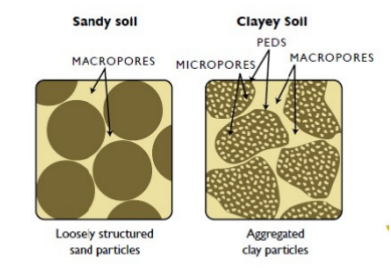
5. The presence of living plants coupled with the ease of replacement of soil air with atmospheric air:
6. The extent of soil compaction whether it’s from machinery or splattering of raindrops
7. The modification of the original soil by the inclusion of organic matter, cinder or sand.
8. PLANTING OF CROPS : Plants like animals require oxygen for breathing. When plants are grown in the soil, they reduce the oxygen content of the soil air and increase the amount of carbon dioxide. Plants respire by taking in oxygen and letting out carbon dioxide from their roots. This gives reason why the soil must be properly aerated to replace the accumulated quantities of carbon dioxide around the root zone of the plant.
CAUSES OF POOR SOIL AERATION
The factors affecting soil aeration include:
-soil moisture
-soil texture
-infiltration properties
-machinery traffic
-organic matter application
-use for grazing, etc.
These factors may lead to soil compaction, excessive carbon dioxide content, and poor oxygen saturation.
SOIL COMPACTION
In most cases, poor soil aeration is caused by compaction. Compacted soil is a rigid soil mass that prevent air, water and nutrients from reaching plant roots thereby suffocate the roots.
Soil compaction majorly happens on the surface soil layer. Finer soil particles are more prone to compaction, such as clay . The smaller the soil particles, the more densely they attach to each other, leaving less space for oxygen. Lack of oxygen in pore spaces causes neither plants nor aerobic soil biota to survive.
Compaction may be an adverse consequence of irrigation and other field operations.
Field operations that involves use of tractors and trucks can compact the soil. Even foot traffic from frequently walking in one area can cause compaction. Livestock can compact the soil if they are left in one place for too long. This is one reason why it’s crucial to practice livestock rotation. Large or dense root structures can cause soil compaction in landscape beds. One solution to the issue of soil compaction is for vehicles to use the lowest possible tire pressure to minimize damage.
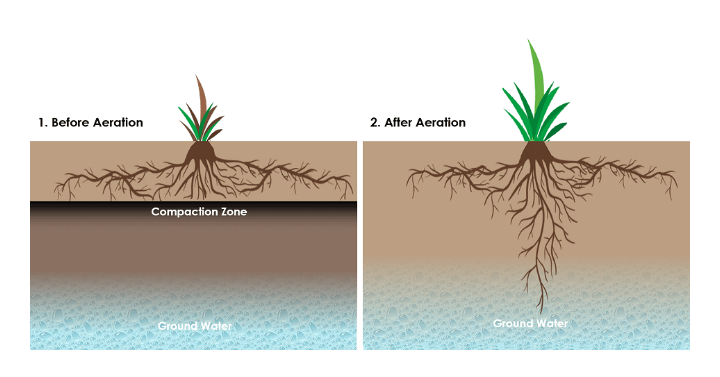
WATERLOGGING
Waterlogging can be induced by natural forces such as heavy rainfall or anthropogenic factors such as flooding and runoff. Waterlogged soils will result in lack of soil aeration. After heavy downpours, floods, or excessive irrigation, water fills up the soil pore space, displacing the air in the pore spaces and reduce the oxygen level to nearly zero. This will affect any plant growing on such soils except water loving plants like swamp rice. However, when the soil dries up again, the air – water balance is restored. Water evaporates, and the air gets back to soil.
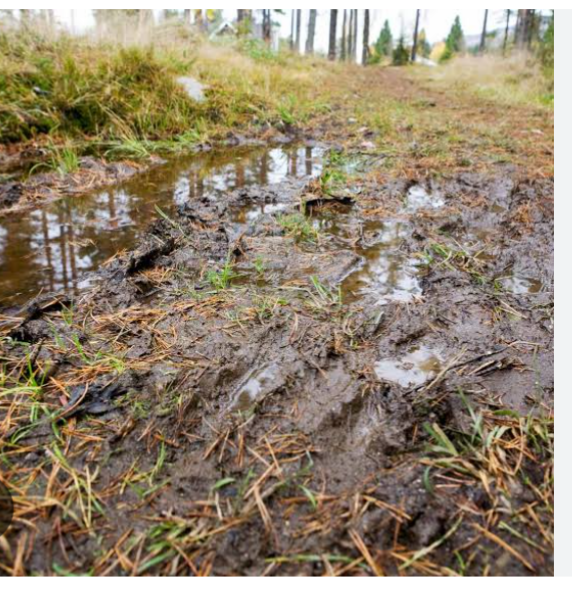
SOIL ORGANIC MATTER
Organic matter boosts soil fertility, improves soil structure, improves soil health and create more pore spaces within the soil mass. The decomposition of organic matter by soil microbs also result in a strong carbon dioxide release. Consequently, when organic matter content is too high, the production of CO2 may be too fast and when its removal is slowed down, a toxic levels may be reached, thus, affect plant and soil microbs survival. Also, carbon dioxide retention do interfere with oxygen supply. Plant roots depend on this oxygen and it is also used during soil air and atmospheric air exchange. This is why it is necessary to add organic matter moderately or in an already decomposed state.
GRAZING WITH LIVESTOCK
Grazing practices contribute to soil fertility by supplying organic manure. Also, livestocks also cause soil compaction around the pasture area if confined around the area. They use their hoofs to trample on the soil as they graze. In this regard, rotational pastures prove to be an efficient problem solution.
REGULAR VEHICULAR TRAFFIC
During tillage operations and transportation of farm produce, tractors and other heavy machinery are used. The heavy machinery compresses farmland soil, thus leading to compaction and exposure of farm land surfaces to erosion and runoff. This can cause sealing up of pore spaces . For this reason, the movement of massive field equipment like tractors, forage harvesters, manure spreaders, and trucks etc., should be limited, and conservation farming can be practiced.
EFFECT OF SUBOPTIMAL AERATION
1. EFFECT ON PLANTS : Poor soil aeration on the growth of plants result in wilting of the plants with the wilting starting from the lower leaves first which later spread to the whole plant should the condition continues.
2. After wilting, the leaves may turn brown or yellowish in colour and eventually curl up and drop.
3. Plants grown on soils slightly deficient in oxygen will exhibite a reduced growth rate, it will be smaller in size compared to that growing in well aerated soil, with less vigorous top and reduced root system.
4. Lack of oxygen supply to plants result in limited branching of the roots and reduction in the number of root hairs produced
5. Lack of oxygen also affect water absorption and translocation within the plants.
6. Both aerobic and anaerobic conditions affect absorption and accumulation of ions which depend on the metabolic processes of the plant cell.
REMEDY TO POOR AERATED SOILS
There is no easy way to determine whether the soil aeration potential is good or poor, personal knowledge of the soil and the response of the plant grown in it are the best source of information to determine soil aeration condition.
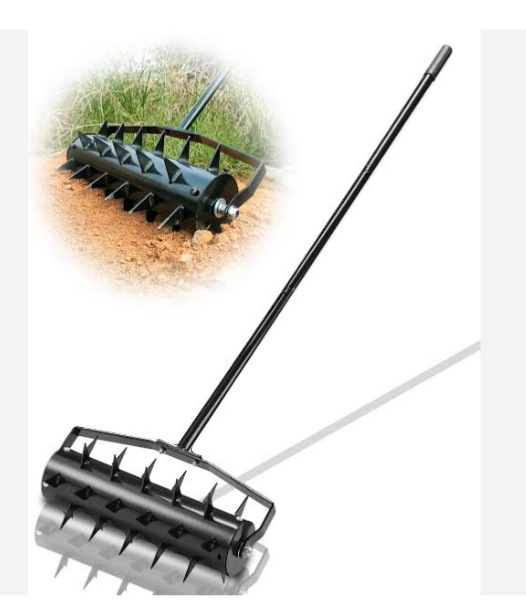
1. In containers or other tight locations of the garden, it may be necessary to hand drive a single spike to aerate compacted soil.
2. Building raised landscape berms or digging planting holes two to three times the width of the plant’s root ball can also help prevent garden soil compaction.
3. Earthworms can be added to the soil in garden beds or containers and allow them to do the work of aerating while adding organic matter for nutrient uptake.
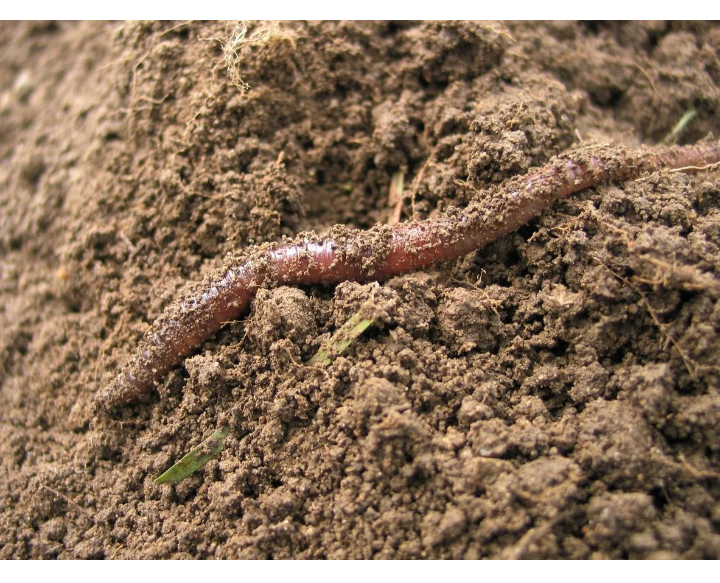
4. Soil aeration is usually done either with a plug aerator or a spike aerator. A plug aerator removes cylindrical plugs from the soil. A spike aerator pokes holes in the soil with a spike. Most lawn professionals recommend using plug aeration because piercing the soil with spikes may cause more soil compaction
5. The air capacity of heavy soil and drainage capacity can be increased by the addition of organic matter, cinders or sand. The organic matter can be inform of crop residues, manure, or peat moss.
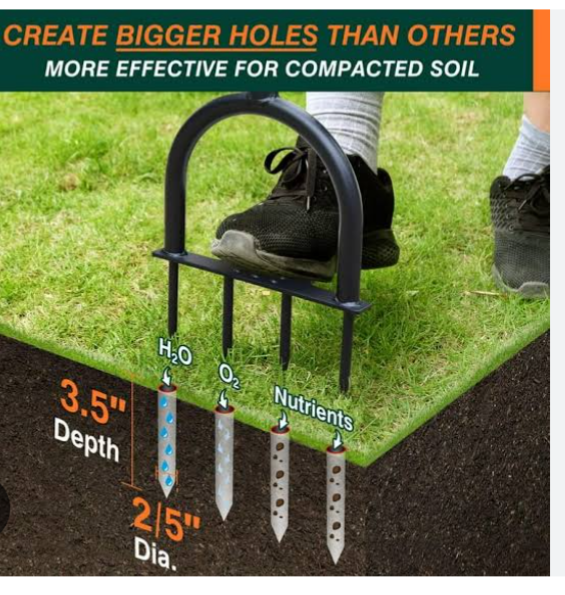
EXPLANATIONS OF OTHER TERMINOLOGIES USED IN SOIL AERATION
SOIL AIR CAPACITY: This is the fractional volume of air in the soil at field capacity air content. That is, the quantity of air in soil after soil has being saturated and allowed to drain between 24 to 72 hours.
Simply defined, It is the ability of the soil to make available adequate air for root growth and soil microorganisms.
Mathematically ;
Fa= F – Qfc
Fa = air filled capacity
F = total porosity
Qfc= water content at field capacity
RATE OF MOVEMENT OF SOIL AIR
Change rate of soil air and atmosphere is a key factor in soil aeration rather than the content of it’s various components per se. Soil air-atmosphere gaseous interchange can occur by diffusion or mass flow. Diffusion is the principal mechanism for soil air- atmosphere gaseous exchange. In the soil, microbial and plant root respiration establish gradient level of concentration which becomes the driving force for diffusion process. Diffusion rate is a function of:
1. Concentration gradient or gradient of partial pressure or concentration gradient of any constituent members of variable gas mixture.
2. Temperature: the kinetic energy of molecules of diffusing gases increases with temperature
3. Molecular weight of diffusing gas and this is referred to as Grahams law
4. Cross sectional area through which diffusion occurs.
Therefore, diffusion transport in soil occurs partly in gaseous phase and partly in liquid phase. Gaseous phase means transport of air through pores and liquid and through water film.
For both pathways, diffusion process may be described by fick’s law
q= – D (dc/dx)
Where q= – K(dH/L).
That is, diffusion flux or mass diffusion across unit area per unit time.
D= is diffusion coefficient which is measured in area per time
c= is concentration which is mass of diffusive substances per unit volume and
x= distance
dc/dx= concentration gradient
If partial pressure is considered instead of concentration of diffusive component, then the equation may be written thus:
q= – (D/B) dP/dx
P= Partial pressure
B=ratio of partial pressure to concentration
MASS FLOW OR CONVECTION
This is gaseous flow as a result of gradient of total pressure. That is, the entire mass of air streams from zone of air to zone of lower pressure and the formular for calculating it is
Ja= – Ka/§(dP/dx)
Where
Ja= is the volume flux density of air and it is volume per area per unit time
Ka= is air permeability constant (m/s)
§=is fluid constant or viscosity (kg/ms)
P= Pressure gradient (kg/ms2. m)
Mass flow is important when total pressure exist because of
1. Barometric pressure change in the atmosphere
2. Temperature gradient
3. Wind gust over soil surface
4. Penetration of water during infiltration causing displacement of antisident air
5. Fluctuation of (shallow) water table pushing air upward or drawing air downwards
6. Extraction of soil water by plant roots
7. Short term changes in soil air pressure during tillage or during compaction by machinery
